Decompression illness

Systemic air
embolism and decompression illnes in a scuba diver.. Unenhanced CT shows effacement of cerebral sulci.

Systemic air
embolism and decompression illnes in a scuba diver.. Unenhanced CT shows an area of low attenuation in the right cerebellar medium peduncle (involving the omolateral cerebellar lobe).

Systemic air
embolism and decompression illnes in a scuba diver.. MR image on coronal view (FLAIR sequence) shows an increase of signal in corrispondence of the left thalamus (arrow).

Systemic air
embolism and decompression illnes in a scuba diver.. This MR axial scan shows the involvement of both thalami (arrows).

Systemic air
embolism and decompression illnes in a scuba diver.. Arrow shows gas in left innominate vein.
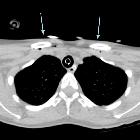
Systemic air
embolism and decompression illnes in a scuba diver.. Gas in retroclavear vessels.
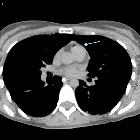
Systemic air
embolism and decompression illnes in a scuba diver.. Gas in pulmonary trunk.
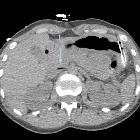
Systemic air
embolism and decompression illnes in a scuba diver.. Arrow shows gas in the inferior vena cava at the confluence of the renal veins.

Systemic air
embolism and decompression illnes in a scuba diver.. Gas in the inferior vena cava in a upper level, shortly before the outlet in the right atrium.
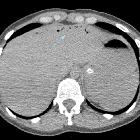
Systemic air
embolism and decompression illnes in a scuba diver.. Arrow shows gas bubbles in some portal branches for the left hepatic lobe.
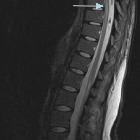
Systemic air
embolism and decompression illnes in a scuba diver.. MR imaging on sagittal view in T2WI with fat signal saturation. Arrow shows a linear area of hyperintensity involving the spinal cord at T8-T9 level, indicative of hypoxic suffering.

Systemic air
embolism and decompression illnes in a scuba diver.. The previous MR imaging finding (T2WI), on axial view.
Decompression illness (DCI) results from a reduction in the pressure surrounding a body. It can occur in divers, compressed air workers, aviators and astronauts.
Diving-related decompression illness is classified into two main categories:
- arterial gas embolism (AGE) secondary to pulmonary decompression barotrauma
- decompression sickness (DCS) (also known as the bends or caisson disease)
Pathology
The body takes in extra oxygen and nitrogen when exposed to high pressure. The oxygen is consumed by body tissues whereas nitrogen dissolves in blood. If the ambient pressure decreases too quickly, the nitrogen separates out of blood and forms bubbles in body tissues and the bloodstream.

